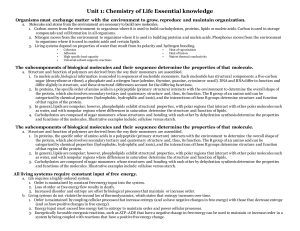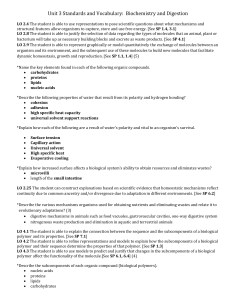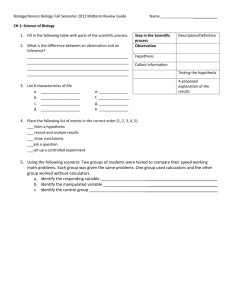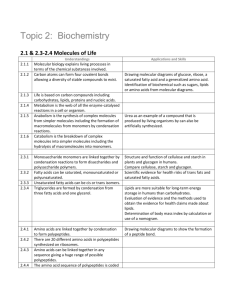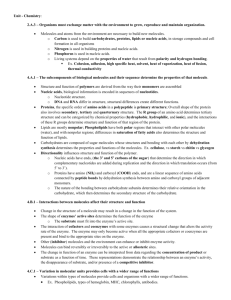Unit 2 Essential Knowledge
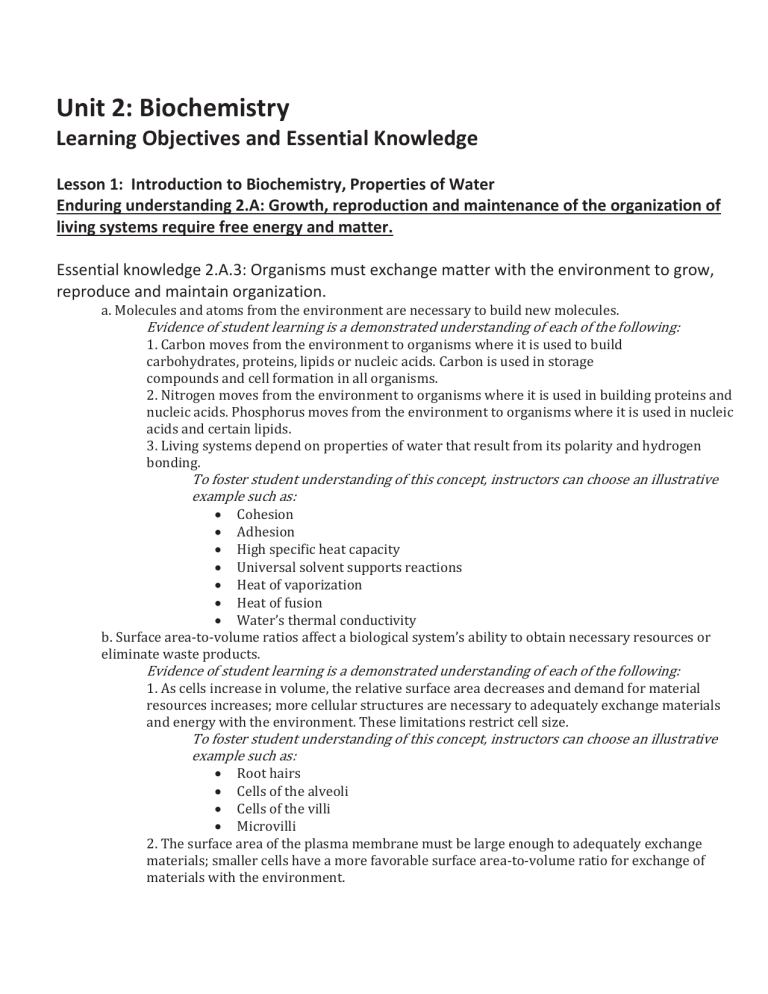
Unit 2: Biochemistry
Learning Objectives and Essential Knowledge
Lesson 1: Introduction to Biochemistry, Properties of Water
Enduring understanding 2.A: Growth, reproduction and maintenance of the organization of living systems require free energy and matter.
Essential knowledge 2.A.3: Organisms must exchange matter with the environment to grow, reproduce and maintain organization.
a. Molecules and atoms from the environment are necessary to build new molecules.
Evidence of student learning is a demonstrated understanding of each of the following:
1. Carbon moves from the environment to organisms where it is used to build carbohydrates, proteins, lipids or nucleic acids. Carbon is used in storage compounds and cell formation in all organisms.
2. Nitrogen moves from the environment to organisms where it is used in building proteins and nucleic acids. Phosphorus moves from the environment to organisms where it is used in nucleic acids and certain lipids.
3. Living systems depend on properties of water that result from its polarity and hydrogen bonding.
To foster student understanding of this concept, instructors can choose an illustrative example such as:
Cohesion
Adhesion
High specific heat capacity
Universal solvent supports reactions
Heat of vaporization
Heat of fusion
Water’s thermal conductivity b. Surface area-to-volume ratios affect a biological system’s ability to obtain necessary resources or eliminate waste products.
Evidence of student learning is a demonstrated understanding of each of the following:
1. As cells increase in volume, the relative surface area decreases and demand for material resources increases; more cellular structures are necessary to adequately exchange materials and energy with the environment. These limitations restrict cell size.
To foster student understanding of this concept, instructors can choose an illustrative example such as:
Root hairs
Cells of the alveoli
Cells of the villi
Microvilli
2. The surface area of the plasma membrane must be large enough to adequately exchange materials; smaller cells have a more favorable surface area-to-volume ratio for exchange of materials with the environment.
Learning Objectives:
LO 2.6 The student is able to use calculated surface area-to-volume ratios to predict which cell(s) might eliminate wastes or procure nutrients faster by diffusion.
LO 2.7 Students will be able to explain how cell size and shape affect the overall rate of nutrient intake and the rate of waste elimination.
LO 2.8 The student is able to justify the selection of data regarding the types of molecules that an animal, plant or bacterium will take up as necessary building blocks and excrete as waste products.
LO 2.9 The student is able to represent graphically or model quantitatively the exchange of molecules between an organism and its environment, and the subsequent use of these molecules to build new molecules that facilitate dynamic homeostasis, growth and reproduction.
Lesson 2: Macromolecules
EU 4.A: Interactions within biological systems lead to complex properties.
Essential knowledge 4.A.1: The subcomponents of biological molecules and their sequence determine the properties of that molecule.
a. Structure and function of polymers are derived from the way their monomers are assembled.
Evidence of student learning is a demonstrated understanding of each of the following:
4. Carbohydrates are composed of sugar monomers whose structures and bonding with each other by dehydration synthesis determine the properties and functions of the molecules.
Illustrative examples include: cellulose versus starch. b. Directionality influences structure and function of the polymer.
Evidence of student learning is a demonstrated understanding of each of the following:
3. The nature of the bonding between carbohydrate subunits determines their relative orientation in the carbohydrate, which then determines the secondary structure of the carbohydrate. a. Structure and function of polymers are derived from the way their monomers are assembled.
Evidence of student learning is a demonstrated understanding of each of the following:
3. In general, lipids are nonpolar; however, phospholipids exhibit structural properties, with polar regions that interact with other polar molecules such as water, and with nonpolar regions where differences in saturation determine the structure and function of lipids. [See also 1.D.1,
2.A.3, 2. B.1]
_____________________________________________________________
a. Structure and function of polymers are derived from the way their monomers are assembled.
Evidence of student learning is a demonstrated understanding of each of the following:
1. In nucleic acids, biological information is encoded in sequences of nucleotide monomers.
Each nucleotide has structural components: a five-carbon sugar (deoxyribose or ribose), a phosphate and a nitrogen base (adenine, thymine, guanine, cytosine or uracil). DNA and RNA differ in function and differ slightly in structure, and these structural differences account for the differing functions. [See also 1.D.1, 2.A.3, 3.A.1] b. Directionality influences structure and function of the polymer.
Evidence of student learning is a demonstrated understanding of each of the following:
1. Nucleic acids have ends, defined by the 3' and 5' carbons of the sugar in the nucleotide, that determine the direction in which complementary nucleotides are added during DNA synthesis and the direction in which transcription occurs (from 5' to 3'). [See also 3.A.1]
a. Structure and function of polymers are derived from the way their monomers are assembled.
Evidence of student learning is a demonstrated understanding of each of the following:
2. In proteins, the specific order of amino acids in a polypeptide (primary structure) interacts with the environment to determine the overall shape of the protein, which also involves secondary tertiary and quaternary structure and, thus, its function. The R group of an amino acid can be categorized by chemical properties (hydrophobic, hydrophilic and ionic), and the interactions of these R groups determine structure and function of that region of the protein.
[See also 1.D.1, 2.A.3, 2.B.1] b. Directionality influences structure and function of the polymer.
Evidence of student learning is a demonstrated understanding of each of the following:
2. Proteins have an amino (NH
2
) end and a carboxyl (COOH) end, and consist of a linear sequence of amino acids connected by the formation of peptide bonds by dehydration synthesis between the amino and carboxyl groups of adjacent monomers.
Learning Objectives:
LO 4.1 The student is able to explain the connection between the sequence and the subcomponents of a biological polymer and its properties. [See SP 7.1]
LO 4.2 The student is able to refine representations and models to explain how the subcomponents of a biological polymer and their sequence determine the properties of that polymer. [See SP 1.3]
LO 4.3 The student is able to use models to predict and justify that changes in the subcomponents of a biological polymer affect the functionality of the molecule. [
Untested:
✘
The molecular structure of specific nucleotides is beyond the scope of the course and the AP Exam.
✘
The molecular structure of specific amino acids is beyond the scope of the course and the AP Exam.
✘
The molecular structure of specific lipids is beyond the scope of the course and the AP Exam.
✘
The molecular structure of specific carbohydrate polymers is beyond the scope of the course and the AP
Exam.
Biochemistry Unit Objectives
1.
Why is matter necessary for biological systems?
2.
Explain the uses of carbon, hydrogen, oxygen, nitrogen, phosphorous and sulfur in biological systems.
3.
Diagram the exchange of matter between organisms and the environment.
4.
What function does nitrogen serve in proteins? In nucleic acids?
5.
What function does phosphorus serve in nucleic acids? In phospholipids?
6.
Why do biological systems need water?
7.
How does the structure of a water molecule relate to its function(s)?
8.
How does the polarity of water lead to the emergence of unique properties in liquid water?
9.
Compare the synthesis and decomposition of biological macromolecules.
10.
Where does the energy needed to drive the synthesis of biological macromolecules come from?
11.
How does the structure of <polysaccharides, proteins, nucleic acids> influence the function of those molecules?
12.
How does the structure of DNA contribute to its roles in protein synthesis and heritability?
13.
Why is DNA a good molecule for information storage?
14.
How do the differences in the structure of DNA and RNA contribute to the difference in the functions of those molecules?
15.
Explain how the sequence of amino acids in a protein determines each level of that protein’s structure.
16.
Explain how the conditions of the environment that a protein is in affect the structure and function of that protein.
17.
Explain how the structure of lipids determines the polarity of the molecule.
18.
If the chemistry of water occurs in aqueous solution, why are lipids useful in biological systems?
19.
Why is starch easily digested by animals, while cellulose isn’t?
20.
Explain how directionality influences structure and function of the following polymer:
1.
Nucleic acids
2.
Proteins
3.
Carbohydrates
21.
Describe the relationship between the structure and function of enzymes.
22.
Explain how environmental conditions can affect enzyme function. Provide examples.
23.
Explain how enzymes accomplish biological catalysis. Provide examples.
24.
Describe how enzyme-mediated reactions can be controlled through competitive and non-competitive interactions.
25.
Propose experimental designs by which the rate of enzyme function can be measured and studied.

